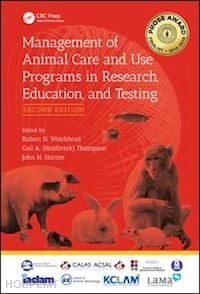Foreword Preface to the Second Edition Editors Contributors Reviewers Section I Introduction/Historical Overview 1. Evolution of Laboratory Animal Program Management by James F. Taylor Section II Developing a Collaborative Culture of Caring 2. Culture of Care: Organizational Responsibilities by Marilyn J. Brown, Camellia Symonowicz, Leticia V. Medina, Natalie A. Bratcher, Cindy A. Buckmaster, Hilton Klein, and Lynn C. Anderson 3. Fostering Collaborative Roles and Responsibilities for Members of an IACUC or Oversight Body by Ernest D. Prentice, M. Elizabeth Blackburn, and Robert S. Dixon 4. Bioethics and Animal Use in Programs of Research, Teaching, and Testing by Richard C. Simmonds 5. Behavioral Management Programs to Promote Laboratory Animal Welfare by Mollie A. Bloomsmith, Jaine E. Perlman, Eric Hutchinson, and Mark Sharpless 6. Education and Outreach Programs by Daniel T. Stimson Section III Compliance, Assessment, and Assurance 7. Compliance and Regulatory Programs by William W. King, Yasmina A. Paramastri, and Javier Guillén 8. Harmonizing International Animal Care and Use Programs by John F. Bradfield, Javier Guillén, and Lynn C. Anderson 9. Assessment and Accreditation Programs for Research Animal Care and Use by Christian E. Newcomer and Sylvie Cloutier 10. Facilitating the Research Process: Limiting Regulatory Burden and Leveraging Performance Standards by Joseph D. Thulin, Valerie K. Bergdall, and John F. Bradfield Section IV Program Management and Stewardship of Resources 11. Human Care by Pamela A. Straeter, Carolyn M. Malinowski, and Laura A. Conour 12. Education and Training by Bruce W. Kennedy and Kim Froeschl 13. Fiscal Management by Stephen J. Pomeroy and Theodore Plemons 4. Occupational Safety and Health by James M. Schmitt, Deborah E. Wilson, and James M. Raber 15. Program Documentation and Monitoring by William E. Dale, George J. Haluska, and Diane (Dee) Horne 16. Existing and Emerging Information Technology by Thomas R. Meier and Kenneth R. Boschert 17. Emergency Response and Management by Lynell M. Dupepe, John C. Donaho, and Gordon Roble Section V Physical Plant 18. Facility Design, Planning, and Renovation by Michael J. Huerkamp, David Mallon, and Gerald Percifield 19. Special Security Considerations for Protecting Programs That Use Animals by John J. Sancenito, Norman Mortell, Michael Stephens, and Robert H. Weichbrod Section VI Environment and Housing 20. Environmental Factors: Macroenvironment versus Microenvironmentby Margaret C. Hogan, John N. Norton, and Randall P. Reynolds 21. Small Animal Enclosures and Housing by Debra L. Hickman, Judy M. Hickman-Davis, Jessica Peveler, and Melissa Swan 22. Large (Nonagricultural) Animal Enclosures and Housing by Jeffrey D. Wyatt 23. Agricultural Animals by Janice C. Swanson, Larry T. Chapin, and F. Claire Hankenson 24. Aquatics by Christian Lawrence, George E. Sanders, and Carole Wilson 25. Nontraditional Species by Dorcas P. O’Rourke, James D. Cox, and Diana P. Baumann Section VII Husbandry 26. Basic Animal Facility Management by Jori K. Leszczynski, Jamie Tackett, and Michelle Wallace-Fields 27. Feed and Bedding by Ronald L. Carter and Neil S. Lipman 28. Water Quality and Water Delivery Systems by E. Douglas Allen, Edgar F. Czarra, and Louis DeTolla 29. Management of Research Animal Breeding Colonies by James J. Elliott, Charles T. Miller, James A. Hagarman, Stephen T. Kelley, Suzette D. Tardif, Sander O. Hacker, and Amanda Bettis 30. Managing Husbandry Programs Involving Experimental Hazards by James R. Swearengen, Rebecca K. Holt, and Ronald L. Bowman Section VIII Animal Health and Care 31. Veterinary Care by James M. Raber, Marek Niekrasz, Jan Linkenhoker, and Kathy A. Perdue 32. Behavioral Training as Part of the Health Care Program by Steven J. Schapiro, Elizabeth R. Magden, Lisa A. Reamer, Mary Catherine Mareno, and Susan P. Lambeth 33. Managing Animal Colony HealthbyKerith Luchins and George Langan 34. Surgery by Randall R. Clevenger, Jan Bernal, Michael Talcott, Teresa R. Gleason, Tracie Rindfield, and Robert F. Hoyt Jr. 35. Euthanasia by Christine P. Sivula and Mark A. Suckow Section IXConclusion 36. Future Directions and Challenges by Joseph N. Benoit, Robert H. Weichbrod, John N. Norton, and Janet C. Garber Index











